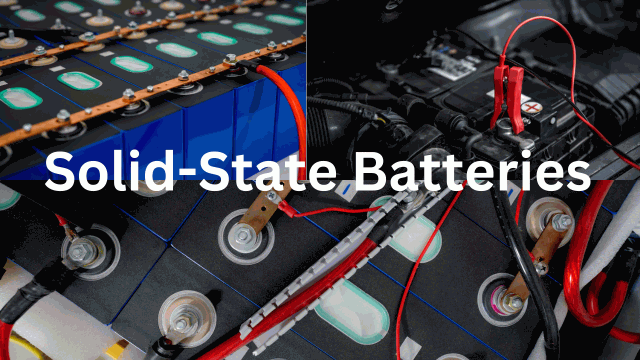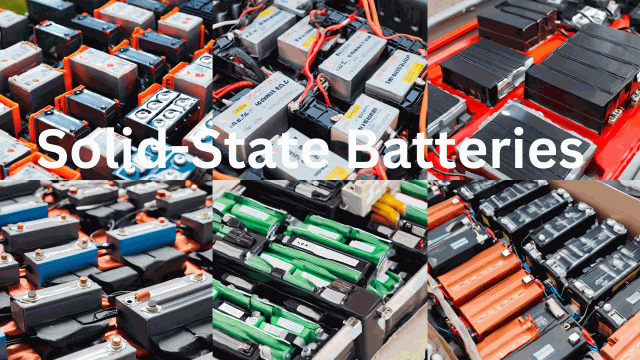Solid-State Batteries: Revolutionizing Energy Storage
Preface
In recent years, the pursuit of sustainable and efficient energy storage solutions has led to significant advancements in battery technology. One such breakthrough is the development of solid-state batteries, a revolutionary alternative to traditional lithium-ion batteries.

In this editorial, we delve into the intricacies of solid-state batteries, exploring their composition, benefits, and potential applications that are poised to reshape the energy landscape.
♦ Understanding Solid-State Batteries
Composition and Working Principles
Solid-state batteries represent a paradigm shift in energy storage by replacing the liquid or gel electrolytes found in conventional lithium-ion batteries with solid electrolytes. These solid electrolytes serve as a bridge for ions to flow between the cathode and anode, facilitating the electrochemical reactions that store and release energy.

The key components of a solid-state battery include:
Comprising a high-capacity material such as lithium iron phosphate (LiFePO₄) or lithium nickel cobalt manganese oxide (LiNiCoMnO₂), the cathode acts as the positive electrode, accepting electrons during charging.
Anode
Typically constructed from lithium metal or alternative materials like silicon, the anode serves as the negative electrode, releasing electrons during discharge.
This critical component replaces the liquid electrolyte and is responsible for conducting ions between the cathode and anode. Solid electrolytes can be made from various materials, including ceramics, polymers, or glass.

♦ Enhanced Safety and Stability
One of the most compelling advantages of solid-state batteries lies in their improved safety profile. The absence of flammable liquid electrolytes significantly reduces the risk of thermal runaway and associated safety hazards.
Moreover, solid-state batteries exhibit enhanced resistance to overcharging and short circuits, making them a safer choice for a wide range of applications.
♦ Unraveling the Benefits
The energy density of solid-state batteries is higher than that of their liquid electrolyte equivalents. This means they can store more energy in a smaller footprint, paving the way for compact and lightweight energy storage solutions. This characteristic is particularly valuable in industries where space constraints or weight considerations are paramount.
Faster Charging and Discharging Rates
The unique structure of solid state batteries enables rapid ion movement within the solid electrolyte, resulting in significantly faster charging and discharging rates. This not only enhances the overall efficiency of energy transfer but also opens doors to applications demanding quick bursts of power, such as electric vehicles and grid-level energy storage.
Solid-state batteries exhibit impressive cycle life, retaining a higher percentage of their initial capacity over numerous charge and discharge cycles. This longevity is attributed to the inherent stability of solid electrolytes, which are less prone to degradation compared to their liquid counterparts.

♦ The Future Landscape: Applications and Implications
Electric Vehicles (EVs)
Solid-state batteries hold immense potential for revolutionizing the automotive industry. Their high energy density, coupled with rapid charging capabilities, addresses the key limitations of current lithium-ion batteries. The transition to solid-state technology could lead to EVs with extended ranges and shorter charging times, accelerating the global shift towards sustainable transportation.
The integration of solid-state batteries into energy grids offers a transformative solution for renewable energy sources. Their ability to store and release energy efficiently complements the intermittent nature of renewables like solar and wind power. This integration facilitates grid stabilization and enables a more reliable and sustainable energy supply.
Conclusion: Pioneering the Energy Revolution
Solid-state batteries represent a pivotal advancement in energy storage technology, offering a compelling alternative to traditional lithium-ion batteries. With their superior safety, higher energy density, and rapid charging capabilities, solid state batteries are poised to drive innovation across various industries, from transportation to renewable energy integration.
As research and development efforts continue, the widespread adoption of solid-state batteries promises a more sustainable and efficient future for energy storage.

In conclusion, the era of solid state batteries is upon us, promising a brighter and more sustainable future for energy storage. As industries and researchers continue to invest in this groundbreaking technology, we stand on the cusp of a new energy revolution where safety, efficiency, and environmental consciousness converge. Embracing solid-state batteries is not merely an option; it is a necessity for a greener tomorrow.
FAQs:
Ans: Solid-state batteries are a new generation of energy storage devices that use solid electrolytes instead of liquid or gel-based ones. This fundamental shift enhances safety, energy density, and charging rates compared to conventional lithium-ion batteries.
Which are a solid-state battery’s essential parts?
Ans: A solid state battery comprises a cathode (positive electrode), which is typically made of materials like lithium iron phosphate or lithium nickel cobalt manganese oxide.
It also includes an anode (negative electrode), often constructed from lithium metal or alternative materials like silicon. The critical component is the solid electrolyte, which conducts ions between the cathode and anode.
Ans: Solid state batteries offer enhanced safety due to the absence of flammable liquid electrolytes. This significantly reduces the risk of thermal runaway and associated safety hazards. Additionally, they demonstrate superior resistance to overcharging and short circuits.
How do solid state batteries contribute to higher energy density and faster charging rates?
Ans: More energy can be stored in a smaller space by solid-state batteries because of their higher energy density. The unique structure of solid state batteries also enables rapid ion movement within the solid electrolyte, resulting in significantly faster charging and discharging rates. This makes them highly efficient in energy transfer.
What industries stand to benefit the most from the adoption of solid-state batteries?
Ans: Solid-state batteries have far-reaching implications across various industries. They hold immense potential for revolutionizing the electric vehicle (EV) industry by addressing the limitations of current lithium-ion batteries.
Additionally, the integration of solid-state batteries into energy grids complements the intermittent nature of renewable energy sources like solar and wind power, leading to a more reliable and sustainable energy supply.
Get access all prompts: https://bitly.com/xyz







